Jacob Gens
Jacob Gens was appointed by the Germans in 1941 as head of the Judenrat (Jewish Council) in the Vilnius ghetto. He held this position until September 14, 1943, when he was called to the Gestapo headquarters and shot. The Vilnius ghetto was completely liquidated 10 days later.
Gens established the Ghetto police force, and made it into an orderly and disciplined body for Germans to use its force to assist in the Aktionen that took place in the Ghetto from September to December 1941, in which tens of thousands of Jews were murdered. Gens and his police force had participated in the deportation of Jews to Ponary.
Ghetto chronicler Mendel Balberyszski recorded that Gens told him after the so-called “Old People’s Aktion” in July 1942, in which some 84 elderly people were murdered:
I have no connection with the purge of the elderly. It was an old debt which the Judenrat owed them. They wanted several hundred people, and it was with great difficulty that the `price’ was reduced to 100 aged…
On occasions he had stood at the ghetto gate and personally selected those who were to live and those who were to die. In the Gelbschein Aktionen that took place between 24 October 1941 and 3 November 1941, Gens himself had checked the papers of the Jews as they passed before him.

According to other available evidence, Gens, within the framework of his role, did his best to aid the Jews. He became the predominant personality in the Ghetto and its de facto Governor. His direct contact with the German authorities, bypassing the Judenrat, added to his prestige among the Jews in the Ghetto. Gens involved himself in affairs that had nothing to do with the police, employment, cultural activities and other aspects of Ghetto life.
In July 1942 the Germans dismissed the Judenrat and appointed Gens as head of the Ghetto Administration and sole representative of the Ghetto (Ghettovorsteher), thereby making official his de facto position.
Gens promoted the idea of “work for life” meaning that the survival of the Ghetto’s depended on their work and productivity. He believed that efforts had to be made to gain time and keep the Ghetto in existence until the Germans were defeated, and that this could be achieved by working for the German war effort.
Order issued by Jacob Gens, head of the Judenrat in the Vilna ghetto, requiring Jews to offer a greeting to any German within the ghetto.
He constantly sought to increase the number of Jews in such positions, in the last few months of the Ghetto’s existence, 14,000 out of the total Ghetto population of 20,000 were employed inside or outside the Ghetto.

Gens, like many other Judenrat leaders, had no reluctance to sacrifice part of jews to save the majority. Therefore he was opposing the partisans, who was trying to get guns, and fight the German forces, by searching their guns stores and denoucing its leaders. For example, he betrayed Yitzhak Wittenberg to Gestapo, who ultimately was calling for armed opposition against Germans because of the incoming end of the war (he was later found dead in the Gestapo cell – poisoned with cyanide). Or Josef Glazman, who was a founder member of partisans organisation (Fareynikte Partizaner Organizatsye) and was a possible threat to the current, Gen’s order of the ghetto.








